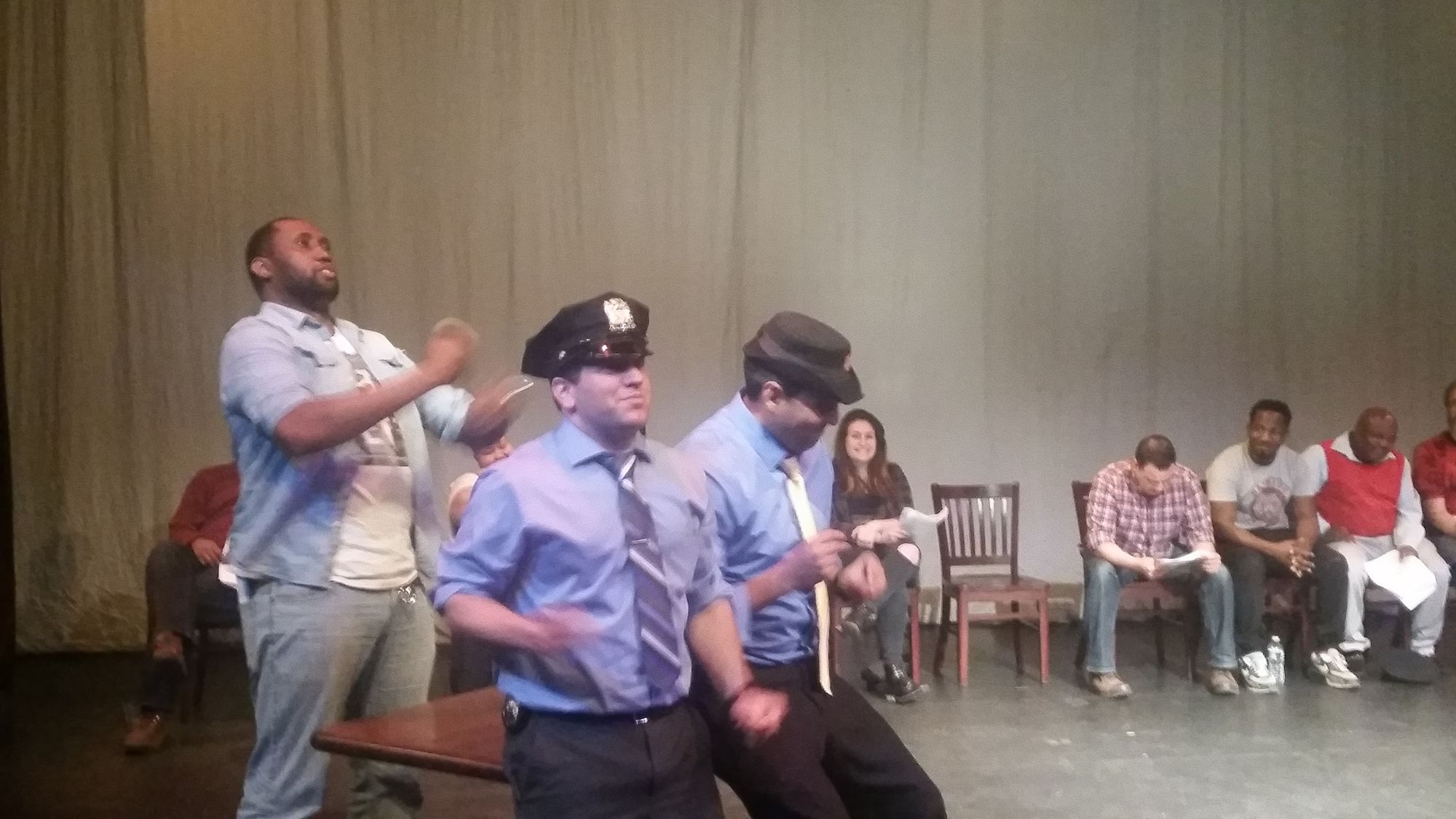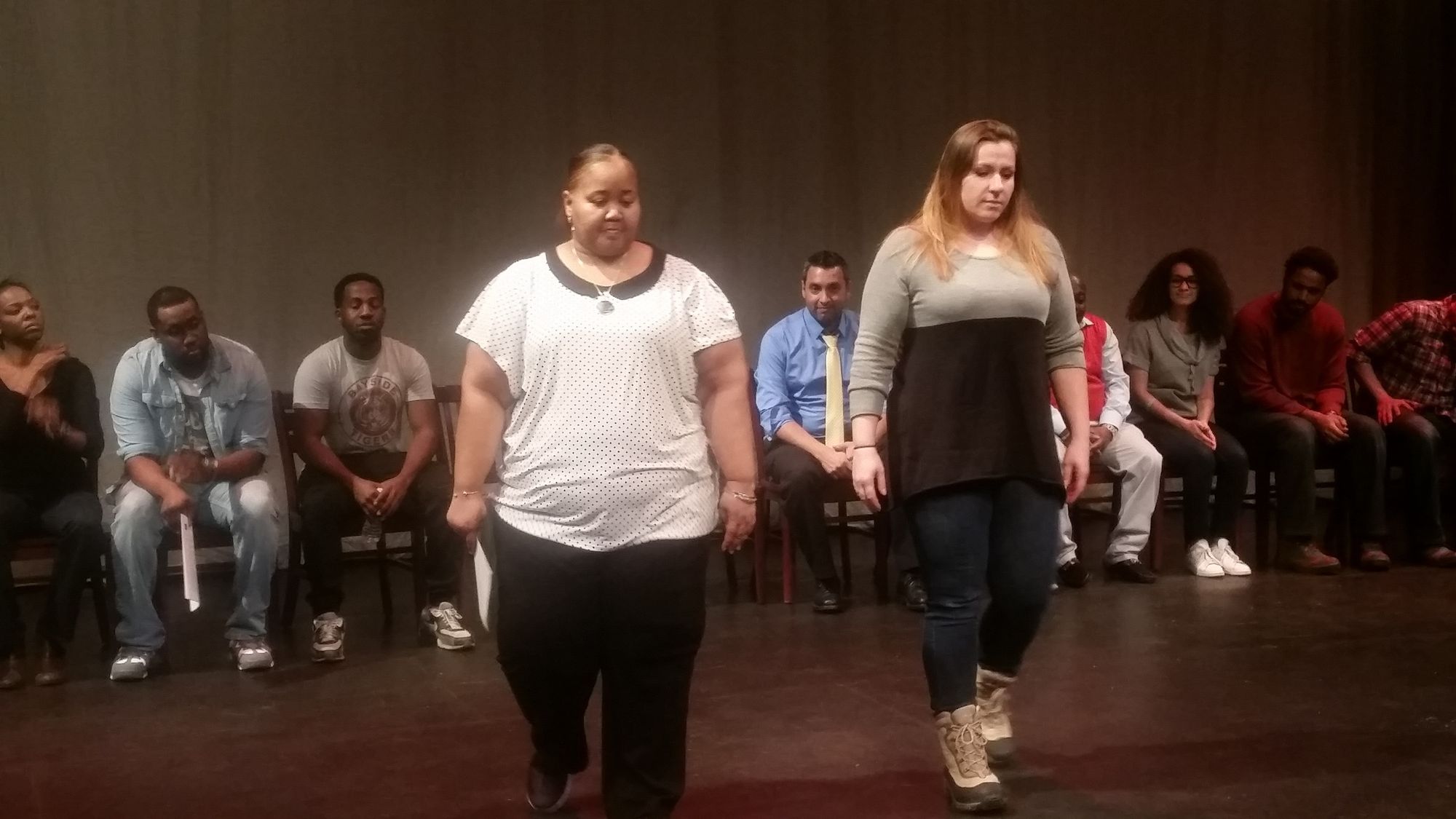To Protect And Serve, One Must Understand: Irondale And NYPD Break Ground With Police-Community Theater Production


The group of 14 adults stand in the middle of the audience-level stage, looking outwards and towards a row of NYPD dress hats lined up in a semicircle around them. Rewind a few moments and they are hugging and exchanging cries of delighted greeting. Fast forward a few moments and half of them are staring soberly at the hats, each stroking them in somber reflection. They place the hats on a friend’s head. It is unknown to the audience whether or which one of them are NYPD officers, and which of them are civilians. It doesn’t matter.
Such is the premise of “To Protect, Serve, and Understand,” a ground-breaking new theatrical production that has civilians and law enforcement working together, interviewing one another, and performing alongside and as one another.
A collaboration between the Irondale Center and the New York Police Department, the production is several months of rehearsals, interviews, and trust-building exercises in the making, and debuts this Friday-Saturday, February 5-6 at 85 South Oxford Street, at 7pm, for free, although RSVPs are encouraged.
“Fort Greene is such a changing community that has changed so quickly. There are a lot of tensions and unease that some neighbors make a thousand times what they do,” said Irondale Project Director Terry Greiss, explaining why our backyard is the perfect place to pilot such a project. “Police are trying to bridge the gap. The big message here is that we’re all only human — that’s what the police caps at the beginning are to show.”
“When people work together — create art together — it allows them to break barriers of “other.” There’s a vulnerability if the art is worth a damn,” added Irondale co-director Michael-David Gordon.

Susan Herman, director of the NYPD’s Office of Community Policing, echoed that need for vulnerability. While observing one of the group’s final rehearsals, she noticed that “they’ve clearly learned about becoming [another person] and getting into other people’s heads.
“It’s important for officers to understand different perspectives, make no assumptions, to listen and really hear people. This stresses that,” Herman said. “This is a great example of promoting understanding. This shows what police officers experience on the street, and the fears and worries they have about their families.”
All of the cops present serve in Brooklyn precincts — the 73rd, 79th, 84th, and 88th — and all but two of the civilians are native or current Brooklynites.
For Police Officer Helen Tazes, 35, who has served for two years at our very own 88th Precinct, volunteering for “To Protect, Serve, and Understand” — a riff on the NYPD motto of “to protect and serve” — was something she wanted to do “because the title of the project is something I can identify with.
“Through communication, we resolve conflict,” Tazes said. “I learned to listen more, and that a lot of what I’m thinking is the same as the public’s thoughts, just from a different perspective.”
For Police Officer Guy Randel, 33, of the 73rd Precinct in Brownsville, he “didn’t know what to expect, but then I got excited. I was apprehensive at first because I expected cop-hating people, but now we’ve come together and see things in the same way.”
As an NCO — shorthand for neighborhood coordination officer — Randel is one of a small contingent of NYPD officers who are being assigned to work neighborhood beats, interacting with residents and earning their trust, in the way cops used to do decades ago.
Asked what he will take away with him onto the job, he said that “a lot of our job is thinking on the fly. This has helped us think more spontaneously. It’s been a lot of fun. I’m gonna miss people and friendships. It helped us listen more.”

That understanding of others goes both ways.
“People’s personal stories are my lesson [of this project],” said Police Officer Jaime Ramirez, 38, of the 73rd Precinct in Brownsville, whose monologue of a Brooklyn resident’s experience being stopped, frisked, and detained with no cause outside his own apartment building is a stomach-turner. “It’s been an eye-opener for [me about] what the other side experiences [of police-community interactions].
For Crown Heights resident and youth development educator Jason Warwin, 42, and Clinton Hill resident Alyx Darensbourg, 26, hearing officer’s perspectives was also eye-opening.
“There was a double appeal [in participating],” explained Warwin. “I am very concerned about police-community relations, especially as it relates to black-Latino youth, and I am also a lover of theatre. I believe in its power to transform people. This has been a learning experience — not transformative, but enlightening. Hearing people’s stories — especially police officers’ — their perspective.”
Darensbourg, who is also a law student, also came into the project concerned about “what law enforcement have been taught” about how to interact with civilians.
“I’m interested in matters of social justice and the opportunity to speak and interact with police officers is wonderful because if we don’t discuss things, we’re never going to learn and understand. The format of improv is great for that,” she said.
“I’ve learned that we’re all people with personal baggage and families at the end of the day. I’ve learned to understand their motivations. Parts of it are enlightening on a human level,” she added. “Also, having an inside track into understanding their training — there is improvement to be had. Laws come from civilians. If we feel something is wrong, we need to change it.”

That notion of working together was a theme that echoed for various participants and observers.
As a former corrections officer, Sikkim Assing, 51, of Fort Greene told us that working within law enforcement for 25 years made her “a believer” in its purpose. “everybody is not the same; some do it good, some do it bad.”
Within the play, Assing plays a mother figure, speaking the words of mothers — including herself — worried about their sons coming home safely, and listing the Top 10 Things To Do If Stopped By A Police Officer.
“I talk to my son all the time, tell him that we are responsible for our own actions,” she said, adding that even so, she is cautious, telling him that ‘do what I say and, most likely, you will be fine. Some people are pushier than others.'”
Looking towards the future, both Greiss (Irondale’s project director) and Herman (NYPD’s OCP director) are hopeful that “To Protect, Serve, and Understand” can be made into a documentary of sorts. Greiss also hopes that it can be replicated elsewhere with training of other theater artists to bring them to their neighborhoods and cities.
“I would like to repeat this several times,” said Greiss. “Everything is filmed and I would love to put together a documentary. I would also like to create an institute to each artists how to work with cops; any well-trained theatre artist can learn theatre games towards that purpose.
“Many of these are Viola Spolin techniques and Irondale techniques. She’s a major influence on our work,” he added. “This is not a flash in the pan.”



